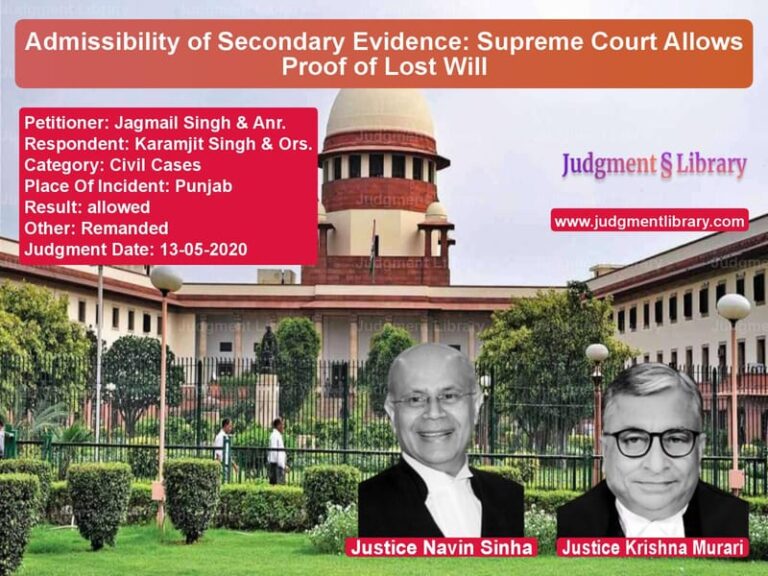Supreme Court Rules on Drug Mixtures Under NDPS Act: Impact on Punishment Criteria
The Supreme Court of India, in the case of Hira Singh & Anr. vs. Union of India & Anr., addressed a crucial issue concerning the Narcotic Drugs and Psychotropic Substances Act, 1985 (NDPS Act). The judgment clarified whether the total weight of a drug mixture or only the pure drug content should be considered while determining punishment under the Act. The Court’s ruling has significant implications for drug-related offenses and sentencing in India.
Background of the Case
The controversy stemmed from the conflicting interpretations of the NDPS Act regarding how drug mixtures should be assessed for sentencing. In the case of E. Micheal Raj vs. Intelligence Officer, Narcotic Control Bureau (2008), the Supreme Court held that only the actual drug content in a mixture should be considered for sentencing purposes, rather than the total weight of the mixture. This ruling led to legal uncertainty, prompting the government to challenge the decision and seek clarity.
To resolve this ambiguity, the Supreme Court constituted a three-judge bench to re-examine the matter and determine whether the total weight of a mixture should be considered in classifying an offense as involving a ‘small’ or ‘commercial’ quantity.
Key Legal Issues Raised
- Should punishment under the NDPS Act be based on the total weight of a drug mixture or only the pure drug content?
- Did the decision in E. Micheal Raj require reconsideration?
- Was the government’s notification, which included the entire mixture weight for classification, legally valid?
Arguments by the Appellants (Hira Singh & Others)
The appellants argued:
- The judgment in E. Micheal Raj was correctly decided, as punishment should be based only on the actual narcotic content, not the total mixture weight.
- The inclusion of neutral substances (such as cutting agents) artificially inflated the weight of drugs and led to harsher sentences.
- The government’s notification treating the entire mixture weight as relevant was an overreach and contradicted the principles of criminal law.
- The NDPS Act should be interpreted in a manner that ensures proportionality in sentencing.
Arguments by the Respondents (Union of India)
The government defended its position by arguing:
- The intent of the NDPS Act was to punish drug-related offenses strictly, considering the entire quantity of seized drugs, including adulterants and cutting agents.
- Drug traffickers often mix narcotics with neutral substances, and considering only pure drug content would allow offenders to escape harsher penalties.
- The 2009 government notification explicitly clarified that the entire mixture should be considered for determining whether the offense involved a ‘small’ or ‘commercial’ quantity.
- The ruling in E. Micheal Raj was erroneous as it failed to consider the legislative intent and the notification issued under the Act.
Supreme Court’s Observations and Ruling
The Supreme Court analyzed the provisions of the NDPS Act and government notifications.
- The Court overruled E. Micheal Raj, holding that punishment should be based on the total weight of the drug mixture, not just the pure drug content.
- The ruling emphasized: “The NDPS Act was enacted to curb drug trafficking, and interpreting it otherwise would defeat its purpose.”
- The Court upheld the validity of the government’s notification, clarifying that the entire quantity of the mixture should be considered.
- It noted that the interpretation ensuring stricter punishment aligned with international drug laws and India’s commitments under the United Nations conventions.
Key Takeaways from the Judgment
- Total Mixture Weight Counts: The Court ruled that the total weight of a drug mixture determines sentencing under the NDPS Act.
- Overruling of E. Micheal Raj: The earlier judgment was set aside, resolving legal uncertainty.
- Stronger Punishment for Drug Offenses: The ruling supports stricter penalties to deter drug trafficking.
- Government’s Notification Upheld: The Court affirmed the notification treating the entire mixture as relevant for classification.
Conclusion
The Supreme Court’s ruling in Hira Singh & Anr. vs. Union of India & Anr. marks a significant shift in drug laws, reinforcing stricter penalties under the NDPS Act. By considering the total weight of a drug mixture rather than just the pure drug content, the judgment aligns with the government’s intent to combat drug trafficking effectively. The decision sets a binding precedent for future cases and ensures that offenders cannot evade harsher penalties by mixing narcotics with neutral substances.
Petitioner Name: Hira Singh & Anr..Respondent Name: Union of India & Anr..Judgment By: Justice Arun Mishra, Justice Indira Banerjee, Justice M.R. Shah.Place Of Incident: India.Judgment Date: 22-04-2020.
Don’t miss out on the full details! Download the complete judgment in PDF format below and gain valuable insights instantly!
Download Judgment: Hira Singh & Anr. vs Union of India & Anr Supreme Court of India Judgment Dated 22-04-2020.pdf
Direct Downlaod Judgment: Direct downlaod this Judgment
See all petitions in Drug Possession Cases
See all petitions in Terrorist Activities
See all petitions in Extortion and Blackmail
See all petitions in Judgment by Arun Mishra
See all petitions in Judgment by Indira Banerjee
See all petitions in Judgment by Mukeshkumar Rasikbhai Shah
See all petitions in dismissed
See all petitions in supreme court of India judgments April 2020
See all petitions in 2020 judgments
See all posts in Criminal Cases Category
See all allowed petitions in Criminal Cases Category
See all Dismissed petitions in Criminal Cases Category
See all partially allowed petitions in Criminal Cases Category







